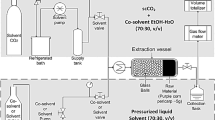Abstract
A combination of high hydrostatic pressure (HHP) and enzymatic hydrolysis (HHP-EH) was applied for the extraction of ginsenosides from fresh ginseng roots (Panax ginseng C.A. Myer). The highest yield of ginsenosides was obtained by using a mixture of three enzymes (Celluclast + Termamyl + Viscozyme) along with HHP (100 MPa, at 50 °C for 12 h) in comparison to control samples (no enzymes, atmosphere pressure, P < 0.05). Total ginsenosides increased by 184 % while Rg1 + Rb1 increased by 273 %. Application of these conditions significantly increased total ginsenosides by 49 % and Rg1 + Rb1 by 103 % compared to HHP treatment alone (P < 0.05). The effect of HHP on increased yield of ginsenosides is likely due in part, to acceleration of enzyme activity. Thus HHP-EH significantly improves the extraction of ginsenosides from fresh ginseng roots.


Similar content being viewed by others
References
Buckow R, Weiss U, Heinz V, Knorr D (2007) Stability and catalytic activity of alpha-amylase from barley malt at different pressure-temperature conditions. Biotechnol Bioeng 97:1–11
Cho WCS, Chung WS, Lee SKW, Leung AWN, Cheng CHK, Yue KKM (2006) Ginsenoside, Re of Panax ginseng possesses significant antioxidant and antihyperlipidemic efficacies in streptozotocin-induced diabetic rats. Eur J Pharmacol 550:173–179
Hou J, He S, Ling M, Li W, Dong R, Pan Y, Zheng Y (2010) A method of extracting ginsenosides from Panax ginseng by pulsed electric field. J Sep Sci 33:2707–2713
Ji QC, Harkey MR, Henderson GL, Gershwin ME, Stern JS, Hackman RM (2001) Quantitative determination of ginsenosides by high-performance liquid chromatography-tandem mass spectrometry. Phytochem Anal 12:320–326
Jiang B, Xiong Z, Yang J, Wang W, Wang Y et al (2012) Antidepressant-like effects of ginsenoside Rg1 are due to activation of the BDNF signalling pathway and neurogenesis in the hippocampus. Br J Pharmacol 166:1872–1887
Kwon JH, Belanger JMR, Pare JRJ (2003) Optimization of microwave-assisted extraction (MAE) for ginseng components by response surface methodology. J Agric Food Chem 51:1807–1810
Lou DW, Saito Y, Paweł K, Zarzycki PK, Ogawa M, Jinno K (2006) Isocratic separation of ginsenosides by high-performance liquid chromatography on a diol column at subambient temperatures. Anal Bioanal Chem 385:96–104
Masson P, Tonello C, Balny C (2001) High-pressure biotechnology in medicine and pharmaceutical science. J Biomed Biotechnol 1:85–88
Qi LW, Wang CZ, Yuan CS (2011) Isolation and anaylsis of ginseng: advances and challenges. Nat Prod Rep 28:467–495
Rivalain N, Roquain J, Demazeau G (2010) Development of high hydrostatic pressure in biosciences: pressure effect on biological structures and potential applications in biotechnologies. Biotechnol Adv 28:659–672
Weemaes C, De Cordt S, Goossens K, Ludikhuyze L, Hendrickx M, Heremans K, Tobback P (1996) High pressure thermal and combined pressure-temperature stability of α-amylases from Bacillus species. Biotechnol Bioeng 50:49–56
Wu J, Lin L, Chau F (2001) Ultrasound-assisted extraction of ginseng saponins from ginseng roots and cultured ginseng cells. Ultrasonic Sonochem 8:347–352
Xiao-Chun C, Yuan-Gui Z, Li-An Z, Chun H, Ying C et al (2003) Ginsenoside Rg1 attenuates dopamine-induced apoptosis in PC12 cells by suppressing oxidative stress. Eur J Pharmacol 473:1–7
Xie JT, Shao ZH, Hoek TLV, Chang WT, Li J et al (2006) Antioxidant effects of ginsenoside Re in cardiomyocytes. Eur J Pharmacol 532:201–207
Xiong Y, Shen L, Liu KJ, Tso P, Xiong Y et al (2010) Antiobesity and antihyperglycemic effects of ginsenoside Rb1 in rats. Diabetes 59:2505–2512
Zhang S, Chen R, Wang C (2007) Experiment study on ultrahigh pressure extraction of Ginsenosides. J Food Eng 79:1–5
Zhang X, Wang J, Xing Y, Gong L, Li H et al (2012) Effects of ginsenoside Rg1 or 17β-estradiol on a cognitive impaired, ovariectomized rat model of Alzheimer’s disease. Neuroscience 220:191–200
Acknowledgments
This research was funded by the Food High Pressure Technology Development Project, Korea Food Research Institute, Korea.
Author information
Authors and Affiliations
Corresponding authors
Rights and permissions
About this article
Cite this article
Sunwoo, H.H., Kim, CT., Kim, DY. et al. Extraction of ginsenosides from fresh ginseng roots (Panax ginseng C.A. Meyer) using commercial enzymes and high hydrostatic pressure. Biotechnol Lett 35, 1017–1022 (2013). https://doi.org/10.1007/s10529-013-1182-x
Received:
Accepted:
Published:
Issue Date:
DOI: https://doi.org/10.1007/s10529-013-1182-x




